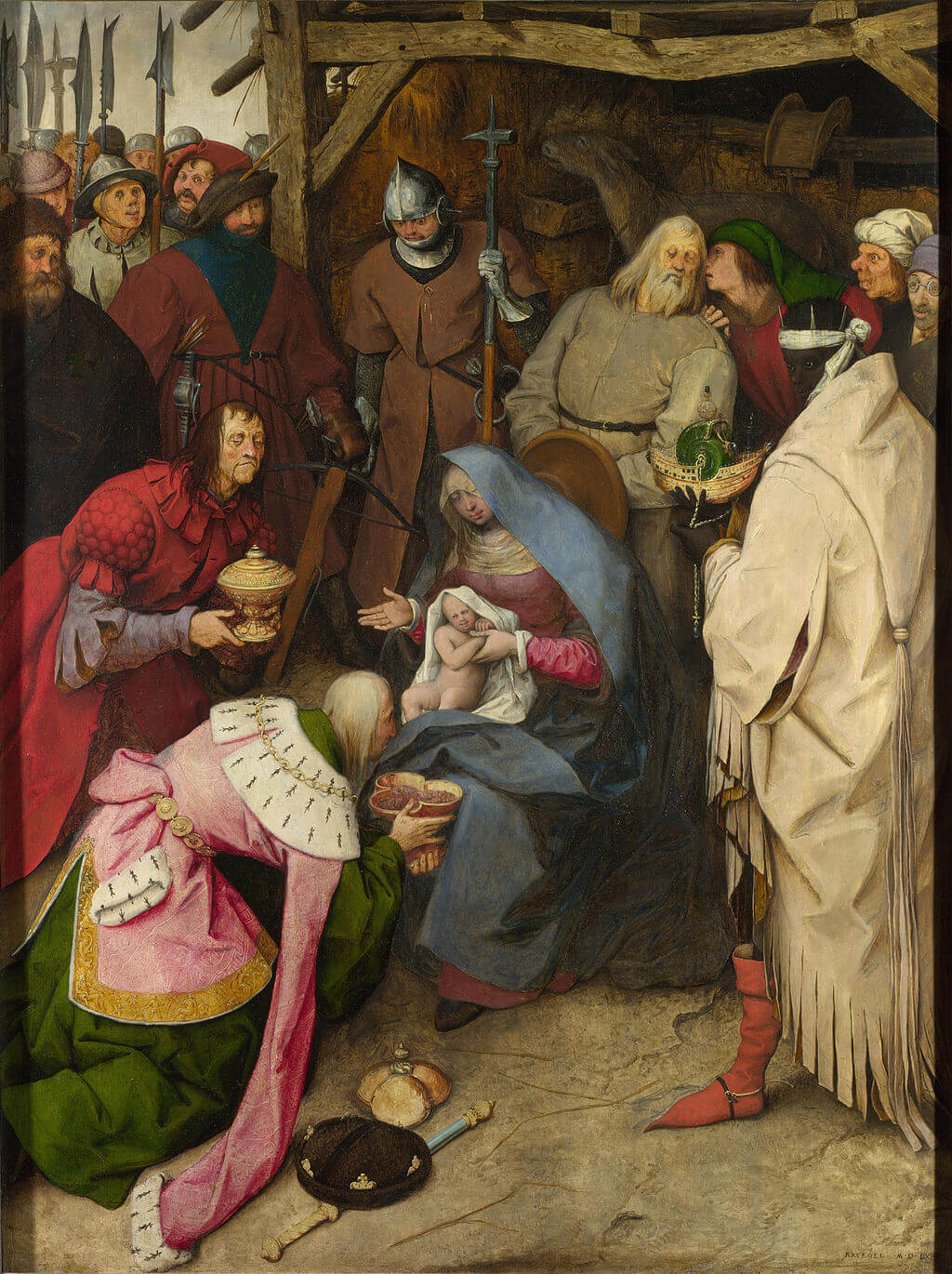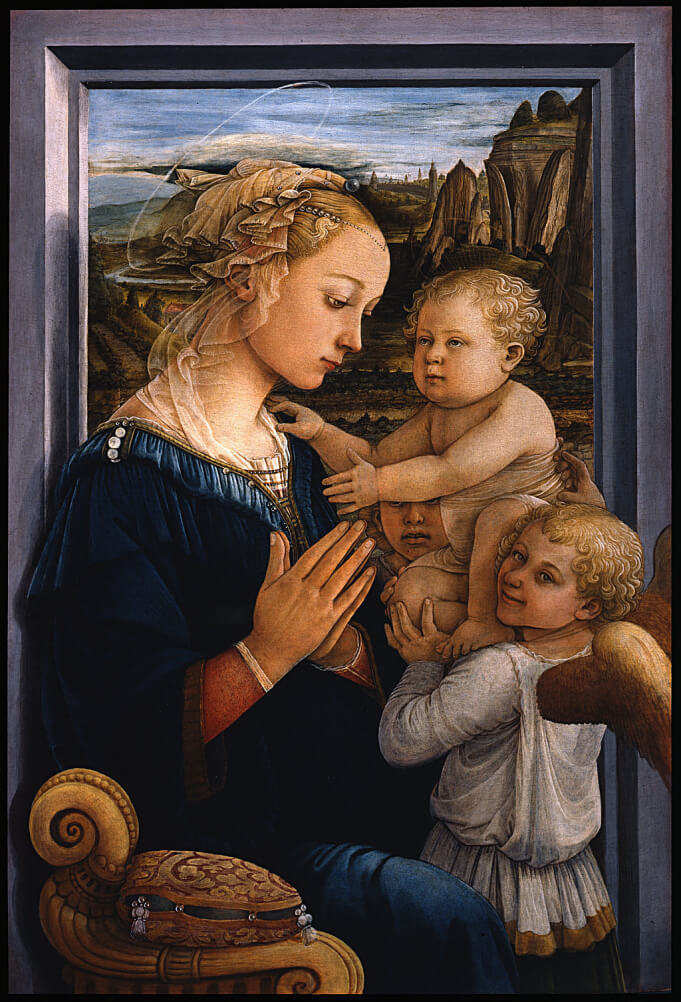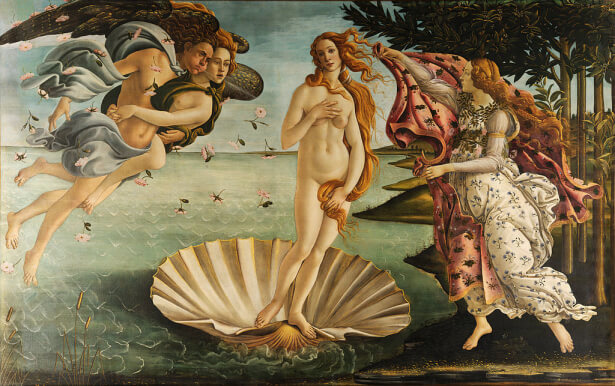|
Where? Gallery 4 of the National Gallery of Art
When? Between 1440 and 1460 Commissioned by? Most likely the Medici family What do you see? This tondo in a gold frame shows hundreds of people lining up to worship Baby Jesus. The line starts at the top right of the painting, goes around the back of the stable and the white building, and continues on the left side of the painting where people are entering under the arch. On the bottom right, the Holy Family is depicted. The Virgin Mary is wearing a blue dress and has Baby Jesus on her lap. You can see some pomegranate seeds next to the left hand of Jesus. To Mary’s right is Saint Joseph. To their left, you can see the typical donkey, ox, and manger. Behind and to the right of Mary and Joseph, you can see the three shepherds present at the birthplace of Jesus. In front of the line of people are the three Magi (also known as the three wise men or three kings) and behind them is their following. The first Magus is kneeling down in front of Jesus and touches his right foot. Jesus raises his right hand to bless him. The other two Magi are waiting behind him. The horses of the Magi are taken care of in the stable. Next to the stable is a group of blind and disabled people. Above them is a white architectural structure in decay and on top of this structure stands a group of five almost naked people. The painting contains various animals, such as cows, horses, camels, a donkey, an ox, a falcon, a peacock, a pheasant, and a dog. The two birds on the right of the stable probably represent a falcon (or a goshawk) attacking a pheasant. On the top right, next to the mountaintop, you can see even more faces cluttered together. Also, below the arch on the left, you can see sketches of more people and animals. Backstory: This painting is also known as the Washington Tondo or the Cook Tondo (named after a former owner of the painting). Fra Angelico started this painting, but before completing it, he was called to Rome by the Pope to complete several commissions in the Saint Peter and the Vatican Palace. Fra Filippo Lippi was then commissioned to finish the painting. In addition, it may be the case that several people in the workshops of both friars may have contributed to the painting. It is not entirely clear who painted which parts of the painting. The general idea is that Fra Angelico painted the figures with the thinner faces (like Mary) and Lippi painted the figures with the broader faces (like Saint Joseph and the Magus holding the foot of Jesus). It is thought that Filippo Lippi completed the majority of the painting. Symbolism: The painting contains various symbolic references:
Why the Adoration of the Magi? This theme was popular among Renaissance painters and has been painted by, among others, Botticelli, Pieter Bruegel the Elder, and Leonardo da Vinci. For example, Adoration of the Kings by Bruegel can be found in the National Gallery in London and Adoration of the Magi by Botticelli can be found in the Uffizi Museum in Florence. An important argument for the popularity of the adoration of the Magi theme is that artists could paint the luxury and colorfulness of the costumes of the Magi and their followers. This theme reflects the biblical story in Matthew 2 about the three kings who traveled a large distance following a big star to worship Baby Jesus. They brought three gifts for Jesus: gold, frankincense, and myrrh.
Who is Fra Angelico? Born as Guido di Petro around 1395, he was better known as Fra Angelico or Il Beato Angelico. He lived a very pious life and died in 1455. He started his career as a manuscript illustrator and moved on to become a painter of frescos and paintings.
He was beatified in 1982 by Pope John Paul II, because of his pious life and the amazing quality of his paintings. He was especially good in painting the most beautiful depictions of the Virgin Mary. One of his great works is the Coronation of the Virgin in the Uffizi Museum. Who is Filippo Lippi? Fra Filippo Lippi (1406-1469) was born in Florence. After his parents died and his aunt could not take care of him anymore, he was sent to a Carmelite convent. Unlike Fra Angelico, he lived a far-from-pious life, though he officially remained a friar throughout his life. He left the convent at age 26 and later in his life he even married and got a child, the well-known painter, Filippino Lippi. The Medici family recognized the talents of Filippo Lippi, and during his career, he completed at least nine paintings for them. One of his most famous works is the Madonna and Child with Two Angels in the Uffizi Museum.
Fun fact: An analysis by the National Gallery of Art has revealed that this painting was created over an extended period of time. It also seems that some of the animals in the painting were not initially included in the design, but only added later on, possibly by another painter than Fra Angelico and Filippo Lippi.
Analysis revealed, specifically, that the peacock, falcon, pheasant, and hunting dog were added on top of areas that were already painted. This was probably under the influence of the Medici brothers Piero and Giovanni. Note that the birds are painted bigger than they should realistically be, compared to the rest of the painting, to emphasize their symbolism. They distract the viewer from the real theme of the painting. Interested in a copy for yourself? Poster or canvas.
2 Comments
Where? Room 8 of the Uffizi Museum
When? 1465 Commissioned by? Uncertain. Originally, Giovanni de’ Medici ordered this painting to give it to the King of Naples, but this deal was abandoned due to a lack of funding for Filippo Lippi. What do you see? A praying Virgin Mary. Two angels are holding the child Jesus in front of Mary. Mary and Jesus both seem to be lost in their thoughts. Mary is depicted in a very elegant way compared to earlier paintings. For example, look at her sweet facial expression and the graceful veils and pearls in her hair. Notice also the halo above the heads of Mary and Jesus. These halos are just a simple circle and mark the transition between the solid gold disks used in earlier work and the disappearance of the halo in later Renaissance paintings. The angel on the right seems to giggle and watch the viewer directly in the eyes. Mary, Jesus, and the angels are depicted in front of a window, which can easily be mistaken for the frame of this painting. In the background, you can see a landscape inspired by Flemish paintings. Backstory: This painting was one of the first in which Mary and Jesus are depicted in a very human way. Mary is shown as an elegant young woman. This painting has served as an inspiration for many future paintings of Mary, but also for paintings of Venus, such as The Birth of Venus by Botticelli (a pupil of Filippo Lippi).
Symbolism: The pearls and veils that are carefully inserted in Mary’s hair and are gracefully draped around her neck are a new element that Lippi introduced to represent the elegance of Mary. The forehead is bigger than usual as the forehead was an object of beauty during that time (see the pearl on Mary’s forehead to emphasize this).
You can see the shadow of Mary in the window frame on the left. This is another example of a physical detail, whereas earlier paintings of Mary focused mainly of the spiritual symbols. However, you can also see a seashore in the landscape, which refers to one of Mary’s titles ‘port of salvation’. The rocks in the landscape refer to the biblical tale of Daniel. Finally, Mary is wearing a blue dress, representing her purity, virginity, and royalty. Who is Madonna? A Madonna is a representation of Mary with or without her child Jesus. Madonna comes from ‘ma donna’, which is Italian for ‘my lady’. In English, this is often referred to as ‘our lady’ and in French as ‘notre dame’. There are different types of Madonna painting. The ‘Madonna and child’ in Lippi's painting was a very popular subject during the Renaissance. Other types of Madonnas that have frequently been used in the art are, for example, the ‘Madonna enthroned’, ‘Madonna of humility’, ‘adoring Madonna’, and ‘nursing Madonna’. Why Madonna? The Madonna and child is the most popular theme in Christian art. Often Mary and Jesus are surrounded by angels or saints that pay their respects to them. Jesus and Mary are the most central figures in Catholicism, and their depiction should remind people of their religion. Who is Filippo Lippi? Filippo Lippi (1406-1469), also called Lippo Lippi, was born in Florence. He was the son of a butcher, but his parents died when he was still young. After his aunt took care of him for a few years, at age eight, he joined the convent of the Carmine where the friars took care of him. The friars discovered his love for art and gave him some great opportunities to pursue a career in art. His son, Filippino Lippi also became a famous painter (and is thought by some to be the model for the giggling angel in this painting). Sandro Botticelli is the most well-known pupil of Filippo Lippi. Another well-known work of Filippo Lippi in collaboration with Fra Angelico is the Adoration of the Magi in the National Gallery of Art.
Fun fact: Filippo Lippi was a Carmelite monk and was supposed to live a celibate life. However, he did not take the rules too strict as he was an extremely lustful man.
When he was in his 50s, he became the chaplain of a convent of nuns, and he fell in love with one of the nuns named Lucrezia Buti. He asked whether Lucrezia could serve as his model for Mary in this painting. This request was granted on the condition that there was always another nun present during these painting sessions. One day Lippi escaped together with Lucrezia from the convent (some stories tell that he abducted her) to live together with her. Together they got two sons. Interested in a copy for yourself? Poster or canvas. |
Categories
All
|
- Home
- Blog
-
Museums
- Alte Pinakothek
- Art Institute of Chicago
- Baltimore Museum of Art
- Barber Institute of Fine Arts
- Bargello
- Barnes Foundation
- British Museum
- Church of Sant’Anastasia
- Cleveland Museum of Art
- Courtauld Institute of Art
- Detroit Institute of Arts
- Frans Hals Museum
- Galleria Borghese
- Gallerie dell'Accademia
- Getty Museum
- Guggenheim
- Hermitage Museum
- Kunsthistorisches Museum
- Kunstmuseum Basel
- Legion of Honor Museum
- Louvre
- Mauritshuis
- Metropolitan Museum of Art
- Musee d’Orsay
- Museum of Fine Arts in Boston
- Museum of Modern Art
- National Gallery in London
- National Gallery of Art
- National Museum in Poznań
- Norton Simon Museum
- Ny Carlsberg Glyptotek
- Palace of Versailles
- Palazzo Pitti
- Palazzo Vecchio
- Petit Palais
- Philadelphia Museum of Art
- Prado
- Pushkin Museum
- Ravenna Art Museum
- Rijksmuseum
- San Diego Museum of Art
- Santa Maria delle Grazie
- St. Peter's Basilica
- Städel Museum
- Statens Museum for Kunst
- Tate Britain
- Tate Modern
- Timken Museum of Art
- Uffizi
- Vatican Museums
- Wallace Collection
-
Artists
- Altdorfer
- Anguissola
- Berlin Painter
- Bosch
- Botticelli
- Boucher
- Bronzino
- Bruegel the Elder
- Brunelleschi
- Cabanel
- Caillebotte
- Canova
- Caravaggio
- Carpeaux
- Cezanne
- Cimabue
- David
- Degas
- Delacroix
- De Maria
- Donatello
- El Greco
- Fontana
- Fra Angelico
- Fragonard
- Gauguin
- Gentileschi
- Gericault
- Gonzalez-Torres
- Goya
- Hals
- Hogarth
- Hokusai
- Ingres
- Leonardo da Vinci
- Lippi, Filippo
- Longhi, Barbara
- Lorrain
- Makovsky
- Manet
- Massys
- Matisse
- Merian
- Michelangelo
- Mochi
- Modigliani
- Monet
- Panini
- Parmigianino
- Perugino
- Picasso
- Pisanello
- Raphael
- Rembrandt
- Renoir
- Reynolds
- Rivera
- Rodin
- Rubens
- Scultori
- Seurat
- Steen
- Tintoretto
- Titian
- Toulouse-Lautrec
- Turner
- Uccello
- Van der Weyden
- Van Dyck
- Van Eyck
- Van Gogh
- Van Hemessen
- Vasari
- Velazquez
- Vermeer
- Veronese
- Vigée Le Brun
-
Locations
- Books
- About Us








